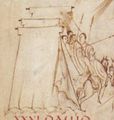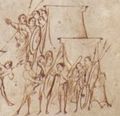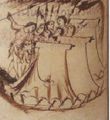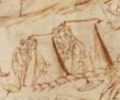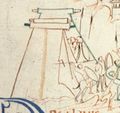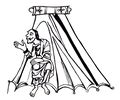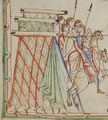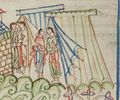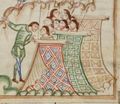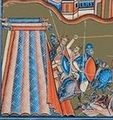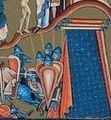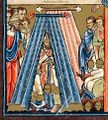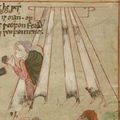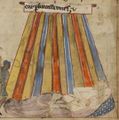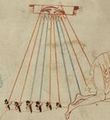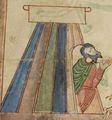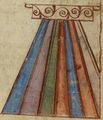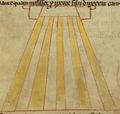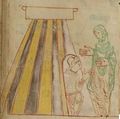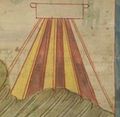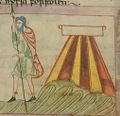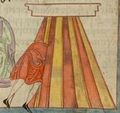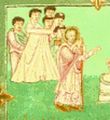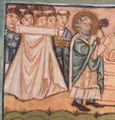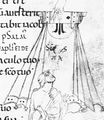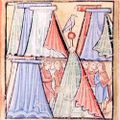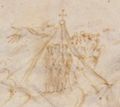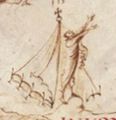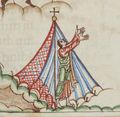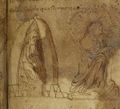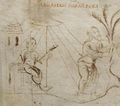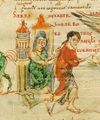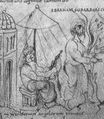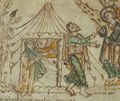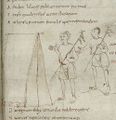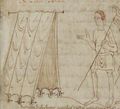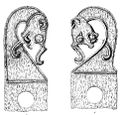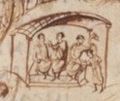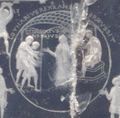Difference between revisions of "Tents & Work Shelters"
m (→Tent Pegs) |
m |
||
| (8 intermediate revisions by the same user not shown) | |||
| Line 1: | Line 1: | ||
| − | {{Stars2|Category= | + | {{Stars2|Category=Furniture & Storage}} |
| − | + | {{Furniture}} | |
==Northern European Tents== | ==Northern European Tents== | ||
Also known as Anglo-Saxon, Saxon or Geteld tents. | Also known as Anglo-Saxon, Saxon or Geteld tents. | ||
| Line 84: | Line 84: | ||
</gallery> | </gallery> | ||
| − | + | <br> | |
==Bell Tents== | ==Bell Tents== | ||
This is a cone shaped tent supported by a single central pole. It is interesting to note that all of the depictions from the Utrecht Psalter depict them with a cross at their apex. Possibly meaning that they were used for Ecclesiastical purposes. | This is a cone shaped tent supported by a single central pole. It is interesting to note that all of the depictions from the Utrecht Psalter depict them with a cross at their apex. Possibly meaning that they were used for Ecclesiastical purposes. | ||
| Line 116: | Line 116: | ||
</gallery> | </gallery> | ||
| + | <br> | ||
==Late Roman army tents== | ==Late Roman army tents== | ||
These consist of two uprights and a simple cross beam. A simple sheet is suspended over this and the ends left open. Examples can be seen in these C6th manuscripts. | These consist of two uprights and a simple cross beam. A simple sheet is suspended over this and the ends left open. Examples can be seen in these C6th manuscripts. | ||
| Line 142: | Line 143: | ||
</gallery> | </gallery> | ||
| + | <br> | ||
==Viking Tent== | ==Viking Tent== | ||
===Oseberg, Norway=== | ===Oseberg, Norway=== | ||
| − | Two tents were found in the Oseberg ship burial.<br> | + | Two tents were found in the Oseberg ship burial. Apparently the original woodwork for the tents other than the carved dragon heads no longer survives. Although it is now impossible to say with any certainty which poles belonged to which tent I have attempted to make a preliminary guess in the image below. <br> |
| − | |||
<gallery> | <gallery> | ||
File:Tent_Oseberg_-_small_head.JPG | Oseberg Small tent | File:Tent_Oseberg_-_small_head.JPG | Oseberg Small tent | ||
| − | |||
| − | |||
| − | |||
| − | |||
File:Tent_Oseberg_-_large_head.JPG | Oseberg Large tent | File:Tent_Oseberg_-_large_head.JPG | Oseberg Large tent | ||
| + | File:Tent_Oseberg_Poles.jpg | Oseberg tent poles | ||
</gallery> | </gallery> | ||
| Line 165: | Line 163: | ||
File:Gokstad_Tent_2.jpg | Gokstad | File:Gokstad_Tent_2.jpg | Gokstad | ||
</gallery> | </gallery> | ||
| + | |||
| + | <br> | ||
==Work Shelters== | ==Work Shelters== | ||
| Line 187: | Line 187: | ||
</gallery> | </gallery> | ||
| + | <br> | ||
==Tent Pegs== | ==Tent Pegs== | ||
===Oseberg=== | ===Oseberg=== | ||
| Line 194: | Line 195: | ||
The following evidence from the Roman period has been included here for comparative evidence. | The following evidence from the Roman period has been included here for comparative evidence. | ||
====Wooden tent pegs==== | ====Wooden tent pegs==== | ||
| − | *Newstead, Oak, triangular section, 250-500mm long [BISHOP | + | *Newstead, Oak, triangular section, 250-500mm long [BISHOP & COULSTON 2006:p.116] |
====Iron tent pegs==== | ====Iron tent pegs==== | ||
We've included these as comparisons. Found in Castle Künzing Quintanis (Germany) they are dated to the 2nd/3rd century AD. The original photo can be found [http://commons.wikimedia.org/wiki/File:Roman_Tent-pegs.jpg here]. A possible argument for the continuation of this style of tent peg as suggested by [http://europa-reenactment.org/saxon_tent.php Europa Reenactment] can be put forward by the pegs illustrated in BL Cotton Claudius B IV fol 21v. | We've included these as comparisons. Found in Castle Künzing Quintanis (Germany) they are dated to the 2nd/3rd century AD. The original photo can be found [http://commons.wikimedia.org/wiki/File:Roman_Tent-pegs.jpg here]. A possible argument for the continuation of this style of tent peg as suggested by [http://europa-reenactment.org/saxon_tent.php Europa Reenactment] can be put forward by the pegs illustrated in BL Cotton Claudius B IV fol 21v. | ||
| Line 201: | Line 202: | ||
File: Tent BL Cotton Claudius B IV fol 21v pegs.jpg | 1025-1050AD English <br> BL Cott Clau BIV f.21v | File: Tent BL Cotton Claudius B IV fol 21v pegs.jpg | 1025-1050AD English <br> BL Cott Clau BIV f.21v | ||
</gallery> | </gallery> | ||
| + | |||
| + | ==References== | ||
| + | {{Ref|Bishop & Coulston 2006}} | ||
| + | {{Ref|British Museum Website}} | ||
| + | {{Ref|Nicolaysen 1882}} | ||
| + | <HarvardReferences /> | ||
Latest revision as of 19:39, 19 December 2016
| Tents & Work Shelters |
|---|
|
|
More Furniture & Storage pages
Northern European Tents
Also known as Anglo-Saxon, Saxon or Geteld tents.
From the Psalters
The Carolingian Utrecht psalter has three surviving copies. These span almost 400 years and can show us how the same scenes can be reinterpreted.
- 820-835AD Utrecht Psalter
- 1025-1050AD & 1125-1150AD London, British Library, MS Harley, 603, Harley Psalter
- 1150AD Cambridge, Trinity College, MS R.17.1, Edwine Psalter
- 1180-1200AD Paris, BNF MS lat. 8846, Anglo-Catalan Psalter
From the Psychomachia
Their are 18 surviving illustrated copies of Prudentius's Psychomachia. Four of which hae been classified as Anglo-Saxon.
Although sharing a common source the Psychomachia from Bern is from a differnt drawing group than the Anglo-Saxon examples.
- 875 – 950AD Bern, Stadtbibliothek, Ms. 264
From the Hexateuch
- London, B.L. Cotton Claudius B IV
From other Manuscripts
- 850-900AD Leiden, I Maccabees
- C10th Fulda Sacramentary
- 1025-1050AD T84 Vatican Biblioteca Apostolica, reg. lat. 12
- 1109-1111AD Dijon Bible of Stephen Harding
- 1155-1160AD New York, Pierpont Morgan, M 724, Edwine Psalter prefatory cycle
Bell Tents
This is a cone shaped tent supported by a single central pole. It is interesting to note that all of the depictions from the Utrecht Psalter depict them with a cross at their apex. Possibly meaning that they were used for Ecclesiastical purposes.
From the Psalters
- 820-835AD Utrecht Psalter
- 1025-1050AD & 1125-1150AD London, British Library, MS Harley, 603, Harley Psalter
- 1150AD Cambridge, Trinity College, MS R.17.1, Edwine Psalter
- 1180-1200AD Paris, BNF MS lat. 8846, Anglo-Catalan Psalter
From the Psychomachia
The English copies of the Psychomachia do not depict bell tents.
Late Roman army tents
These consist of two uprights and a simple cross beam. A simple sheet is suspended over this and the ends left open. Examples can be seen in these C6th manuscripts.
- 493-508AD Milan, Biblioteca Ambrosiana, Cod. F. 205 Inf., Ambrosian Iliad
- 500-550AD Vienna cod. theol. gr. 31, Vienna Genesis
From the Psychomachia
In the Viking Age this style of tent can be seen depicted in the Psychomachia but not in the English versions.
- C9th Leiden, BUR Q3
- 850-900AD Brussels Lat. 9987
- Paris lat 8085
- Valenciennes MS 412
Viking Tent
Oseberg, Norway
Two tents were found in the Oseberg ship burial. Apparently the original woodwork for the tents other than the carved dragon heads no longer survives. Although it is now impossible to say with any certainty which poles belonged to which tent I have attempted to make a preliminary guess in the image below.
Gokstad, Norway
- The parts of the tent are described by Nicolaysen [NICOLAYSEN 1882] thus:
- p.33 “When the ship lay in harbour, it was, at night time covered with a tilt (tjald) to which the recently names pillars and a ridge-pole belonged (tjaldass, tjaldstong). Over this latter the cloth was stretched from both sides of the ship. Sometimes for ornament's sake the cloth was striped in various colours. When it is recorded in Egil's saga, concerning Kveldulf, that he bade his people go along the ship's sides and cut the tilt from it's fastenings (klofi) or when in another passage, the ripping up (spretta) of the tent is spoken of, to me it would seem more probable that the lowest edges of the cloth (tjaldskor) were fastened to the gunwale with ropes than, ……
:p.37-38 c “a bundle of woolen cloth of yellowish colour, though doubtless originally white, with stripes of red cloth sewn thereon (cfr. P. 33) the whole of which, presumably had been intended for the tent, an opinion corroborated by the fact that within the bundle there were found pieces of thin hemp-rope, in all probability, the fastenings of the tilt;” - p.41 q “four long oaken boards of similar size and formed in the same manner, having art the one end animal heads carved and nearly alike one another, and intended to be viewed from both sides, of whose purpose I was for a long time in doubt, until at last it became obvious to me that theu had been placed at each end og the tilt, a conclusion to which I was led by observing the barge boards with horse heads which according to Otte, are found in houses of peasents in Lower Saxony and whose heads in some districts are turned outwards to prevent misfortune, while in others they are directed inwards to bring good luck to the house. It is sufficiently clear that each of the boards must have crossed the other, as represented, and that the ridgepole of the tilt with its ends was pivoted through the holes highest up. To me it also seems most likely …..”
Work Shelters
From the Psalters
- Utrecht Psalter fol.5r, 84r
- Lothair Crystal (British Museum)
Late Roman Work Shelters
- c.427AD Paris BNF Ms. Nouv. acq. lat. 2334
Tent Pegs
Oseberg
The Viking Ship Museum has some 'tent pegs' on display. Dougleen.com however puts forth an alternative theory in that they are rope tension devices.
Roman tent pegs
The following evidence from the Roman period has been included here for comparative evidence.
Wooden tent pegs
- Newstead, Oak, triangular section, 250-500mm long [BISHOP & COULSTON 2006]:p.116
Iron tent pegs
We've included these as comparisons. Found in Castle Künzing Quintanis (Germany) they are dated to the 2nd/3rd century AD. The original photo can be found here. A possible argument for the continuation of this style of tent peg as suggested by Europa Reenactment can be put forward by the pegs illustrated in BL Cotton Claudius B IV fol 21v.










